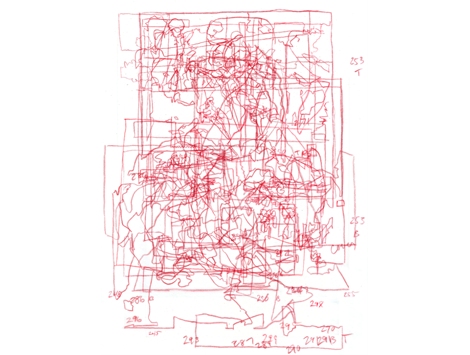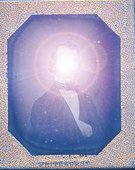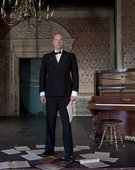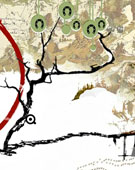These pieces consist of every plate in Beaumont Newhall’s The History of Photography, subjectively traced (ie random parts of figure, ground, shadow or highlight) and layered together into swirling vortices of linear afterimages.
Full Description
I frequently tell my students, “If there’s a photographer you really admire, an image you like, or if you’re just in need of inspiration, trace the image. You’ll learn more about composition than I can teach you in an image lecture.”
Lacking inspiration myself, I decided to take my own advice. To prep for my first time teaching the history of photography, I pulled out my first photo book—Beaumont Newhall’s The History of Photography. For years the definitive work on the subject, it’s since fallen into disfavor among academics, due in part to the fact that it ends around 1975.
These pieces consist of every plate in the book, subjectively traced (ie random parts of figure, ground, shadow or highlight) and layered together into swirling vortices of linear afterimages.
Work metadata
- Year Created: 2012
- Submitted to ArtBase: Wednesday May 30th, 2012
-
Work Credits:
- colerobertson, primary creator
Take full advantage of the ArtBase by Becoming a Member
Artist Statement
In photographing dwarfs, you don't get majesty and beauty. You get dwarfs. Susan Sontag, On Photography
Just about everything in here is imitation something else. Margaret Atwood, Cat’s Eye
The power of a photograph lies in its ability to remain stubbornly embedded in the viewer's subconscious. Photographs are contemplative objects; their static nature invites viewers to gaze for as long or short a time as they wish. Looking away is no defense, however. It's too late. The image becomes emblazoned on the viewer's psyche, ultimately being ingested and transmuted into the viewer's own brain. As memory is selective, subjective, and altogether faulty, this may have unintended consequences.
The power of a photograph lies in its relationship to its photographer. Most cameras have people operating them; so a connection is forged, however indirectly, between the person making the image and the person viewing it. This relationship can be tenuous or remarkably indirect; nonetheless, it exists.
The power of a photograph lies in its ability to forge relationships between unrelated subjects. Flattening three dimensions into two creates an illusion of connectedness for the viewer that may or may not exist in the real world. Likewise, placing a frame around subjects connects them, regardless of their relationship or lack thereof. These perceptions can often lead to misunderstandings hilarious or tragic.
The power of a photograph lies not in what it represents, but rather in what it excludes. The spaces in between, outside, or beyond images contain an infinite number of possibilities, each leading to its own attendant reality. These hypothetical worlds are based in, but not constrained by, the photograph’s connection to the subject it depicts. Relationships may or may not be relative.
The power of a photograph lies in its ability to lie with a straight face.
The power of a photograph lies in its immersion in, and simultaneous removal from, the flow of time.
The power of a photograph lies in its ability to catalog the world, however imperfectly.
The power of a photograph lies in its relationship to the body.
The power of a photograph lies in its relationship to place
The power of a photograph lies in its relationship to objects.
Photography is all these things, and so much more. My work explores the spaces between, before/after, around, or attendant to the photographic image. Through transmutation, alteration, animation, destruction, etc. I disrupt the transaction between viewer and image, hoping to provoke analysis and hinder absorption.





